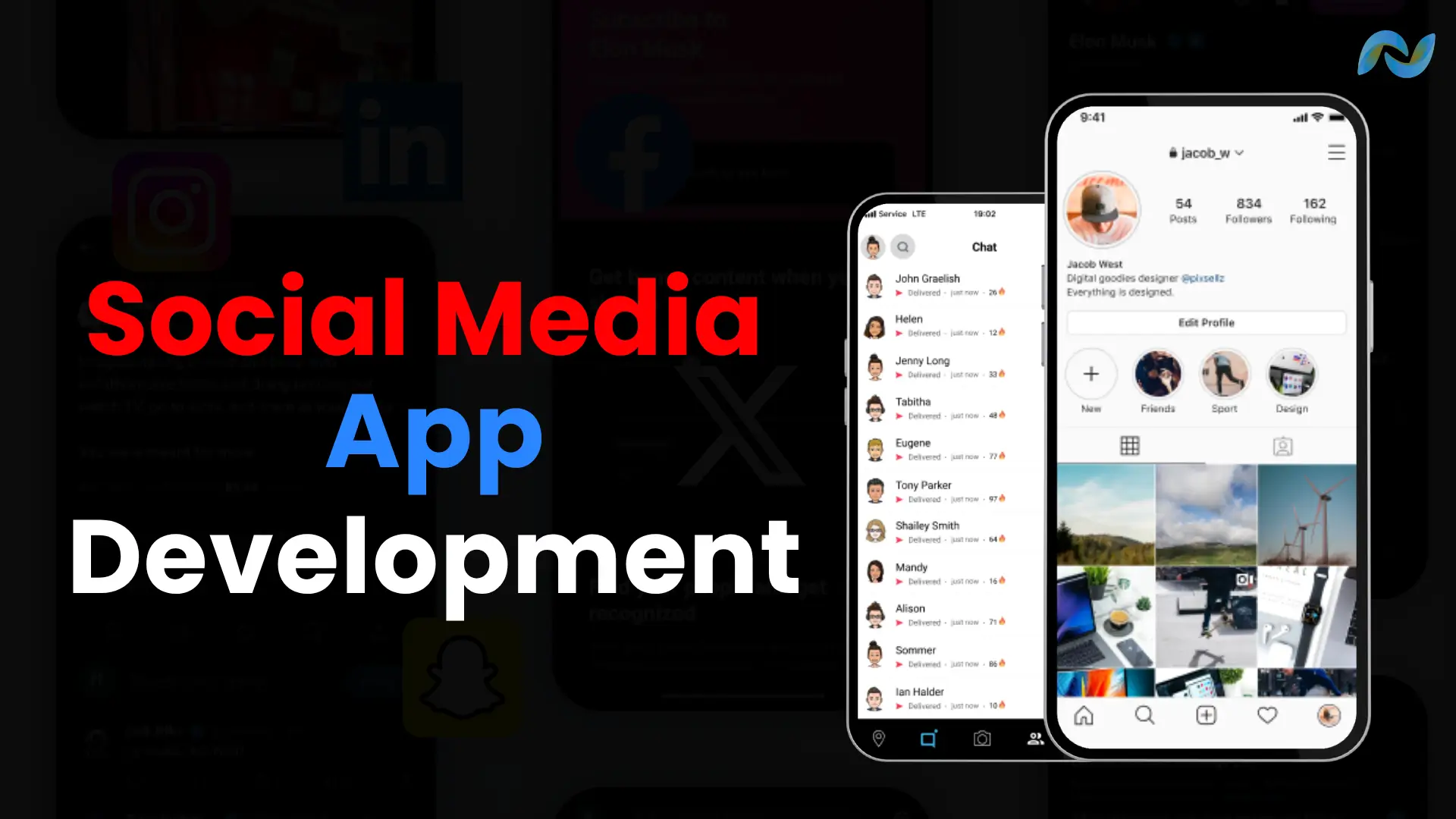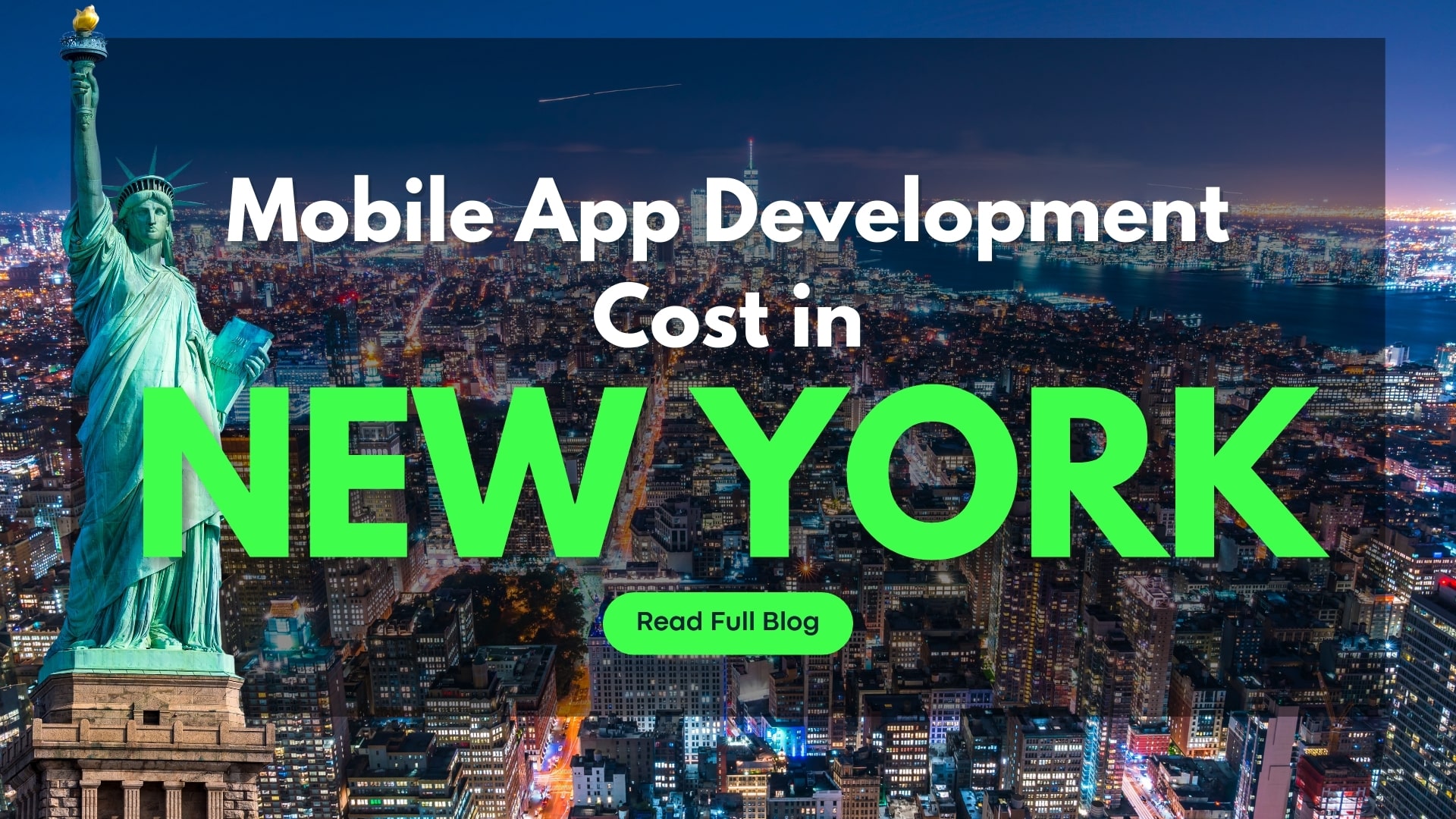Social Media App Development: Features, Cost, and Tech Stack
Are you considering creating a social media application, but unsure where to begin? This guide will help you. In today’s online environment, social media applications serve more purposes than merely sharing images or updates; they connect individuals, build communities, and even enhance businesses. However, transforming an idea into a functional app can seem challenging if you don’t know the process. This guide will simplify the fundamentals of social media Mobile app development. Whether you’re an entrepreneur with an exciting idea or are interested in how platforms like Instagram or Facebook are developed, this guide is here to assist you.
Table of Contents
ToggleWhat is a Social Media App?
A social media application is an application that is available on your phone or computer that enables you to connect and share information with others online. It’s a platform where you can share photos, videos, or messages, keep up with friends and family, and discover what they’re doing. You can also engage by liking, commenting, and messaging others. Popular examples include Facebook, Instagram, TikTok, and WhatsApp. Whether for staying connected, having fun, or even marketing a business, social media apps allow you to interact with the world directly from your device.
What is Social Media App Development?
Creating a social media app is centered around uniting individuals through a digital platform where they can connect, share, and engage. If you’ve ever considered how platforms like Facebook, Instagram, or TikTok came to be, it all begins with someone deciding to build a social media app. Whether it’s for communication, sharing photos, or creating videos, the goal is to make a social media app that fulfills users’ needs in the current digital age. To develop a social media application, you must have a robust plan, integrate features such as user profiles, messaging, notifications, and most importantly, employ a proficient social media app developer who can transform concepts into functional applications. Some individuals also seek to build a social networking app for particular communities or interests, or even tailored versions for local groups or hobbies. In simple terms, social media app development involves transforming your vision of a connected community into an app that people can utilize daily.
Various Types of Social Media Apps

[1] Social Networking Apps
Social networking applications such as Facebook and LinkedIn serve as platforms for establishing and building relationships. You can develop a profile, upload images, share your thoughts, and connect with friends and family. These platforms combine various features such as chatting, browsing updates, joining communities, or even searching for jobs. Whether it’s celebrating a friend’s birthday or sharing personal achievements, these apps enable you to remain socially engaged in the online realm.
[2] Messaging Apps
Messaging applications like WhatsApp, Messenger, or Telegram enable quick and personal communication. You can engage in one-on-one chats, create group conversations, send emojis, voice recordings, photos, and even initiate video calls in an instant. They are excellent for maintaining connections, whether you’re planning weekend activities or checking up on loved ones. Unlike public platforms, messaging apps offer a private, straightforward, and direct experience similar to texting, but more advanced. Many users prefer these applications over traditional texting nowadays.
[3] Photo and Video Sharing Apps
Apps such as Instagram, Snapchat, and Pinterest prioritize visual content. Users use these apps to share photos, reels, or stories that capture moments from their lives. You can discover style advice, recipes, or home decoration ideas simply by scrolling. You can also follow your favourite content creator or celebrity and watch their posts. These applications are popular because they are enjoyable, expressive, and visual. Even if you don’t post, you can still appreciate the content shared by others.
[4] Microblogging Apps
Microblogging applications like Twitter (now X) focus on concise and impactful content. Instead of lengthy posts, users can create quick ideas, news, memes, or opinions in short snippets. You can follow individuals that interest you, and your feed updates in real-time. It’s a favored platform for news, humor, and trending discussions. Whether it’s breaking news, a popular meme, or a personal update, microblogging allows for simple participation in significant conversations with minimal words.
[5] Video Sharing & Streaming Apps
Platforms such as YouTube and TikTok are based on video content. Users can access various materials ranging from tutorials and music clips to comedy videos and behind-the-scenes videos. You can subscribe to channels, like videos, comment, or even create your own. TikTok, in particular, has gained popularity for short-form videos. Whether you want entertainment or aspire to create, these apps allow you to dive in and scroll for hours.
[6] Forums and Community Apps
Platforms like Reddit and Quora prioritize discussion and shared knowledge. They provide spaces where you can ask questions, provide answers, or simply read what others have to say on virtually any subject. From niche interests to personal advice, you’ll find people conversing and supporting one another. The apps are like a large online community or message board rather than a showcase. These platforms are particularly beneficial if you seek genuine perspectives or real-life experiences.
[7] Live Streaming Apps
Twitch, Facebook Live, Instagram Live, and even TikTok Live enable you to watch events as they happen in real-time. Whether someone is gaming, cooking, chatting, or performing, live streams allow you to participate in real time. Viewers have the opportunity to comment, ask questions, or share reactions during the stream. It offers a more intimate connection between creators and their audience.
[8] Review and Recommendation Apps
Review platforms like Yelp, TripAdvisor, or Google Reviews allow people to express candid feedback about places they’ve visited or services they’ve utilized. Many of us consult these apps before trying a new restaurant or reserving a hotel to understand others’ experiences. They prove invaluable in decision-making, and you can view images, read reviews, and gain insights from fellow customers.
[9] Dating Apps
Dating applications such as Tinder, Bumble, and Hinge are customized to assist individuals in meeting new partners or friends. You can create a profile with pictures and a brief bio, then browse through profiles of others nearby. If there’s mutual interest, it becomes a match, allowing you to start a conversation. These apps have transformed the way people connect, making it simpler and quicker to meet someone, whether you’re seeking love, something casual, or just companionship. It’s like online dating made portable, straightforward, fast, and built on shared interests.
General Features of a Social Media Application
In social application development, it is necessary to include advanced features that make the platform highly engaging and usable. Below are some of the general and advanced features that should be included in social media apps:
[1] User Profile Creation
Every user gets a unique personal space to upload a profile picture, write a short bio, and include other essential information. This allows other users to understand who they are engaging with.
[2] News Feed
The feed is the core of any social application, displaying updates, posts, and activities from friends, pages, or groups you follow and conveniently collected in one area.
[3] Follow and Friend Requests
You have the option to send friend requests or follow individuals of interest. This is how you establish connections and view the content shared by others.
[4] Posts and Updates
Users can publish text, images, videos, or even their thoughts. Whether it’s a personal update or a funny meme, posts provide a platform for self-expression.
[5] Reactions and Likes
Clicking the “like” button or using various emojis is a quick method to indicate your enjoyment of someone’s post. It’s an easy way to offer feedback or show appreciation.
[6] Comments
You can respond to posts with comments. This is where most of the discussions begin, allowing individuals to exchange their views on a topic.
[7] Stories
Stories consist of brief photo or video updates that vanish after 24 hours. They’re ideal for sharing experiences or content without making them permanent.
[8] Chat and Messaging
Private messaging enables you to converse either one-on-one or in groups. It’s perfect for quick conversations, sharing information, or just casually chatting with someone.
[9] Push Notifications
You will receive alerts when someone likes your post, comments on it, follows you, or sends you a message. It helps keep you updated on the latest happenings in your feed.
[10] Groups and Communities
You have the opportunity to join or establish groups based on common interests. It’s a place for individuals with similar passions to engage, share content, or ask questions related to any topic.
[11] Search
You can easily locate friends, posts, pages, or hashtags using the search bar. This feature allows you to explore beyond your feed.
[12] Privacy Settings
You can control who can view your profile, posts, or personal details. Whether you prefer a public or private profile setting is your choice.
[13] Tagging and Mentions
You can tag friends in posts or photos, or refer to them in comments using “@”. This is a way to include them in your updates.
[14] Media Sharing
You can share images, videos, and even GIFs through your posts or messages. This enhances the vibrancy of your content.
[15] Live Streaming
You can broadcast live and connect with your audience or friends in real-time, whether it is a concert or a live event.. It’s an excellent way to engage instantly.
[16] Hashtag
Hashtags help in organizing content and enhancing its discoverability. Simply place a “#” before a word for others to find your post using that tag.
[17] Saved Posts and Bookmarking
If you find something interesting but lack the time to explore it now, you can save it. You can revisit it later.
[18] Content Sharing
You can quickly share someone else’s post to your feed or story. It effectively shares content and keeps great material circulating.
[19] Analytics and Insights for Creators
If you manage a public page or frequently post, you can view data on how many people have seen, liked, or interacted with your content, helping you understand what is trending among your audience.
[20] Report and Block
If you find something inappropriate or spammy, you can report it. Additionally, if someone is causing you problems, you can block them to halt any further interaction.
Step-by-Step Social Media Application Development Process

Step 1: Planning and Market Research
Before starting the process to create a social media app, it’s essential to take the time to identify its purpose. Who are you aiming to reach? What features will they require? Analyze other successful applications and consider the factors contributing to their achievements. In this phase, you will establish your objectives, generate ideas, and investigate your competitors. This step forms the groundwork for your social app development journey and ensures that your concept is feasible and necessary in the marketplace.
Step 2: Define Key Features
After clarifying your idea, the next step to create a social network app is to determine its essential features. Consider features like user profiles, news feeds, messaging, notifications, and privacy options. Each of these components is crucial for how users will engage with your platform. Whether you’re designing a social media app similar to Facebook, Instagram, or something entirely different, incorporating the right features is vital for maintaining user interest and satisfaction.
Step 3: Select the Right Tech Stack
When creating a social network app, selecting appropriate tools and technologies is vital. This involves selecting which programming languages, frameworks, and platforms (iOS, Android, or both) you will utilize. Your decisions in this area will influence the speed, security, and adaptability of your app. A clever tech stack facilitates a smoother social media application development process and enables you to scale as your user base grows.
Step 4: Designing the Frontend (UI/UX)
This is where your app concept begins to take shape. To craft a social media app that users will enjoy, the user interface must be straightforward and user-friendly. Consider how users will navigate between screens, how content will be posted, and the ease of interaction with others. A well-crafted social network app feels approachable and engaging, even when executing complex functions behind the scenes.
Step 5: Backend Development
Now comes the phase of actual development. This is when developers write code and connect all components. Whether you’re starting from zero or utilizing a framework, this step brings your social application development plan into reality. Developers create both the front-end (what users view) and the back-end (how functionalities operate in the background). Following good coding practices and having teamwork are crucial for building a seamless social media app.
Step 6: QA Testing and Debugging
Now, after the app is developed, it is time to properly test it to identify bugs and errors. Before the launch, it’s necessary to conduct thorough testing of your app. Testing helps identify bugs, resolve issues, and enhance performance. In this stage of social media application development, real users or testers interact with the app on various devices to verify that everything functions as intended. It’s crucial to address problems now rather than after the app is available to users.
Step 7: Deployment and Launch
Once everything in the app works correctly, it’s time to deploy your app to the public. However, launching goes beyond just uploading it to the App Store or Play Store. You’ll also need to market it. Utilize digital marketing, social media, and word of mouth to generate interest. During social network app development, keep in mind that establishing a robust user base is as crucial as developing the app itself.
Step 8: Post-Launch Maintenance and Support
Even after the launch, the work is not finished. An effective social app development strategy consists of regular updates, bug resolutions, and the integration of new features based on user feedback. As your app attracts more users, you will gain insights into what they appreciate and what requires enhancement. Ongoing support and enhancements are vital for keeping users content and ensuring the continuous growth of your social media app.
Choose an Appropriate Technology Stack
[1] Frontend Development
- Mobile App Development: React Native or Flutter, Swift, Kotlin
- Web App Development: React.js or Vue.js, Next.js
[2] Backend Development
- Node.js with Express.js
- Django (Python)
- Ruby on Rails
- Spring Boot (Java)
- Go (Golang)
[3] Databases
- Relational Databases: PostgreSQL, MySQL
- NoSQL Databases: MongoDB, Cassandra
[5] Cloud and Hosting
- AWS (Amazon Web Services)
- Google Cloud Platform (GCP)
- Microsoft Azure
- Render / Vercel / Netlify
[6] Storage
- Amazon S3
- Cloudinary
[7] Integrations and API
- Firebase Cloud Messaging
- SendGrid / Mailgun
- Twilio
- Stripe / Razorpay / PayPal
[8] AI/ML Features and Functionalities
- TensorFlow / PyTorch
- OpenAI / GPT APIs
- Google Vision API
[9] Authentication and Security
- OAuth 2.0 / OpenID Connect
- Firebase Auth
- JWT (JSON Web Tokens)
- bcrypt / Argon2
- SSL/TLS
[10] Real-Time Features
- Socket.IO / WebSockets
- Firebase Realtime Database / Firestore
- Pusher
[11] Monitoring and Analytics
- Google Analytics / Firebase Analytics
- Mixpanel / Amplitude
- Sentry / LogRocket
- Prometheus + Grafana
[12] Testing Tools
- Jest / Mocha
- Cypress / Playwright
- Postman
[13] CI/CD & DevOps
- GitHub Actions / GitLab CI / CircleCI
- Docker
- Kubernetes
- Terraform
Emerging Technologies to Make a Social Network App
[1] Artificial Intelligence (AI)
AI powers numerous features and functions in today’s social media applications. It helps in suggesting posts, videos, and friends based on your interactions. AI can also identify inappropriate or harmful content and eliminate it, contributing to a safer platform. From intelligent photo tagging to customized feeds, AI enhances the user experience, making it feel more personalized. It is always learning and evolving to ensure that the experience is more enjoyable and meaningful.
[2] Machine Learning (ML)
Machine Learning enables applications to become more intelligent over time. It tracks your app usage, such as what you like, scroll past, or comment on, and uses this data to customize what you view. Machine Learning also helps in essential backend operations like identifying fake accounts, minimizing spam, and boosting security. It’s important to teach the app to understand you better with every action you take.
[3] Blockchain
Blockchain provides a robust layer of security and reliability for social media platforms. Consider it a digital ledger that cannot be modified easily. This technology can enhance the safety of your data, accurately verify identities, and even facilitate cryptocurrency tipping for content creators. Blockchain additionally simplifies proving ownership of content, helping to mitigate issues like plagiarism or digital theft. It’s focused on creating a more transparent and secure app environment.
[4] Cloud Technology
Cloud technology enables social media applications to be quick, adaptable, and accessible from anywhere. When you upload images or videos, they are stored in the cloud rather than solely on your device, allowing you to access them at any time. It also ensures that applications don’t crash when millions of users are online simultaneously. Developers leverage the cloud because it allows them to enhance features or resolve bugs without requiring users to download updated versions regularly.
[5] Data Analytics
Data Analytics collects all the likes, shares, comments, and clicks to convert them into valuable insights. This helps organizations analyze what users enjoy, their peak activity times, and trending topics. Developers utilize this information to refine features and address shortcomings. Advertisers also depend on analytics to present you with more pertinent products or services. It’s all about leveraging data intelligently to enhance the application for both users and businesses.
Factors That Influence the Cost of Social App Development
[1] Features and Complexity
The total cost of your social app increases with the number of features it includes. Basic functionalities such as user profiles, messaging, and photo sharing are less expensive to develop. However, if you wish to incorporate advanced features like video calling, instant notifications, or AI-driven suggestions, it requires a greater investment of time and money.
[2] UI/UX Design
An attractive and user-friendly design is essential for the success of any application. If your app requires custom animations, distinctive layouts, or a tailored aesthetic, it will demand more design effort. Simple designs can be developed more quickly and at a lower cost, but if you aim for a visually unique app, be prepared to spend more on designers and UI/UX specialists.
[3] Platform Selection
The choice of platform, such as iOS, Android, or both, significantly influences the overall price. Developing the app for just one platform is more affordable, but it limits your user reach. Creating the app for both platforms is more costly because developers have to code and test it twice, once for each system. Opting for cross-platform solutions is another possibility, each with its advantages and disadvantages.
[4] Backend Infrastructure
A social app generally needs to store user data, messages, images, and more online. Establishing the backend is important and includes servers, databases, and APIs, all of which require additional costs. If you want a large user base or require your app to function smoothly at all times, you’ll need a robust backend, which further increases expenses.
[5] Security Measures
Social media applications manage personal user information, making security essential. Implementing security measures such as data encryption, secure login systems, and privacy settings can be labor-intensive and costly, but they are crucial. Avoiding this area can result in data breaches and harm to your reputation, so developers tend to devote extra resources to address this aspect properly.
[6] Development Team
The cost of developing your app is also significantly influenced by who is creating it. Employing developers from regions with lower hourly rates, such as India or Eastern Europe, is generally less expensive than hiring teams based in the U.S. or Western Europe. Additionally, while experienced developers may demand higher fees, they usually provide superior quality and complete tasks more quickly, which can lead to cost savings over time.
How Next Olive Can Help in Turning Your Idea Into Reality?
At Next Olive, we do more than just create applications or software; we establish partnerships designed to nurture and elevate your ideas. With over 13 years of experience in the industry, we’ve engaged with various sectors, understanding what strategies giive success and how to overcome typical challenges. Our team, which consists of more than 100 skilled developers, offers a diverse range of expertise to ensure that your project is managed by the right professionals. Whether you’re starting with only a basic idea or have a detailed plan already set, we assist you at every phase, from initial planning and design to development, testing, and final launch.
What makes us unique is our focus on clients. We know that outstanding outcomes come from transparent and honest communication and a complete understanding of your objectives. This is why we ensure complete communication throughout the project, so you’re always informed. We leverage the most current and dependable technologies to guarantee that your product remains modern, scalable, and equipped for future demands. Our agile approach allows flexibility in the process, enabling us to adjust quickly to feedback or changes. Additionally, with well-defined milestones and timelines, you’ll always be aware of what to anticipate and when.Our goal is to transform your idea into a practical solution that benefits both you and your users.
Conclusion
In conclusion, developing a social media application is a long process that begins with a straightforward concept and evolves into a dynamic platform that unites individuals. Although the process consists of planning, designing, and programming, the essential aspect is to focus on what your users genuinely require and appreciate. Whether it involves messaging, sharing, or producing content, your application should facilitate these activities and make them enjoyable. With the right team, clear objectives, and a touch of innovation, you can build an app that is unique in itself in today’s online landscape
Frequently asked questions (FAQs)
Next Olive Technologies is the leading firm that offers social media app development services in over 20 different countries, such as the USA, UK, Australia, etc. The company has over 13 years of experience and over 100 social media application developers.
The cost to develop applications like Facebook and Instagram depends on various factors such as size, type, and complexity of the app. Here is a rough estimate of the cost in 2025:
- Basic App: $30,000 to $90,000
- Medium-Sized App: $90,000 to $200,000
Complex App: $200,000 to over $500,000
To develop a social media app, it is crucial to understand its goals, purpose, and audience. Once it is clear, focus on creating a robust plan for it and implement the ideas into practical.








